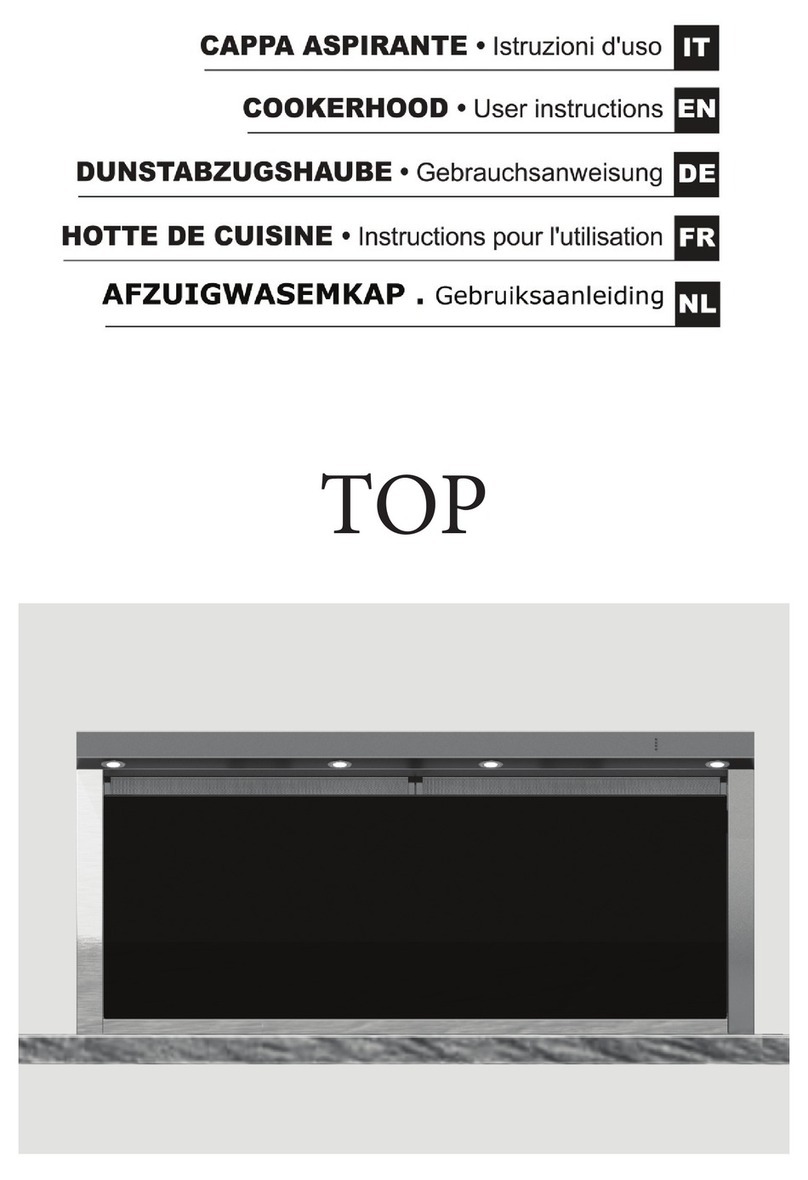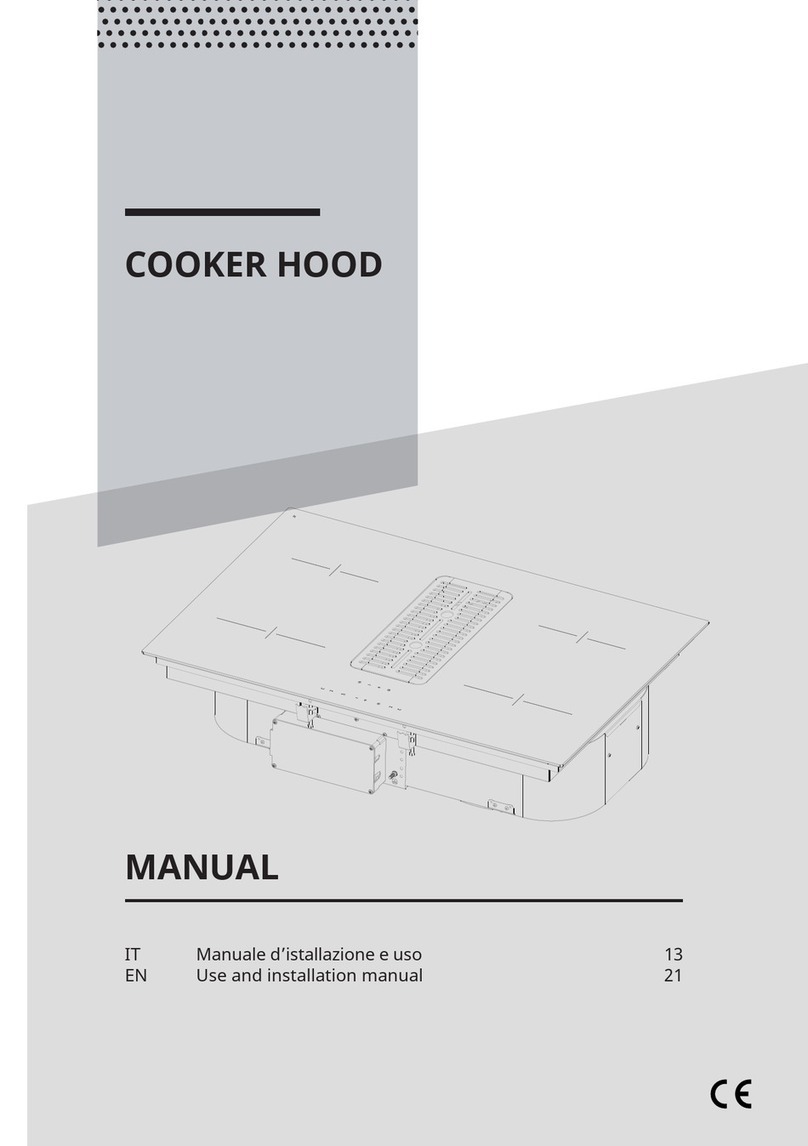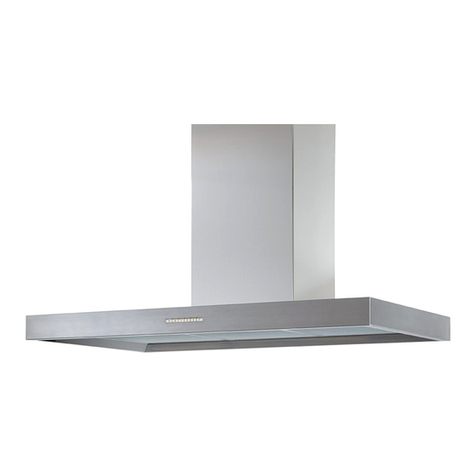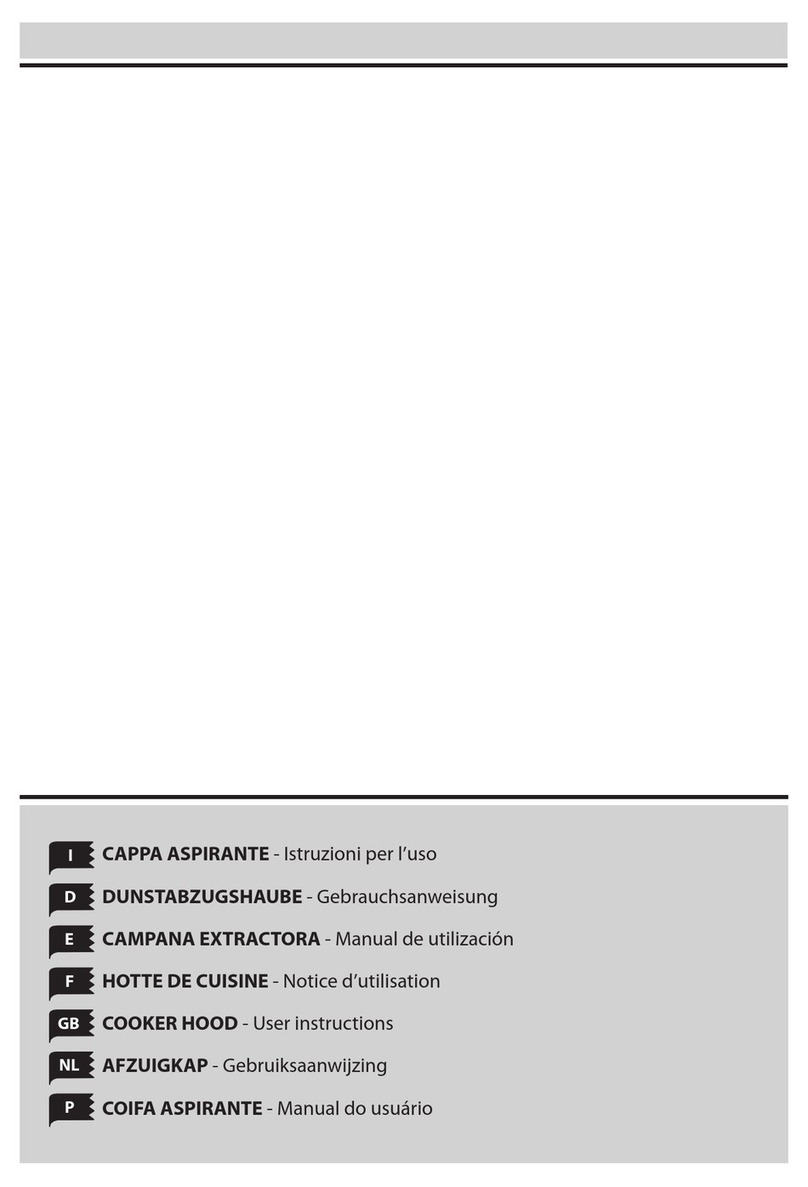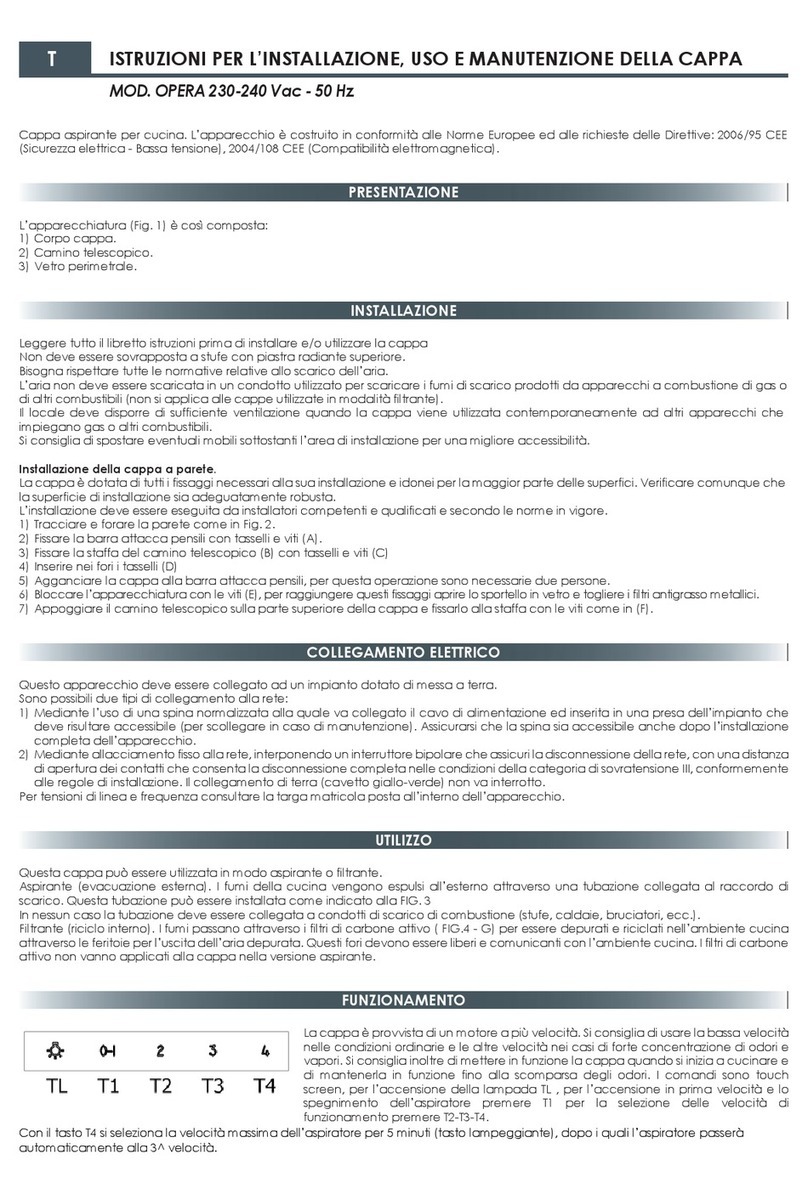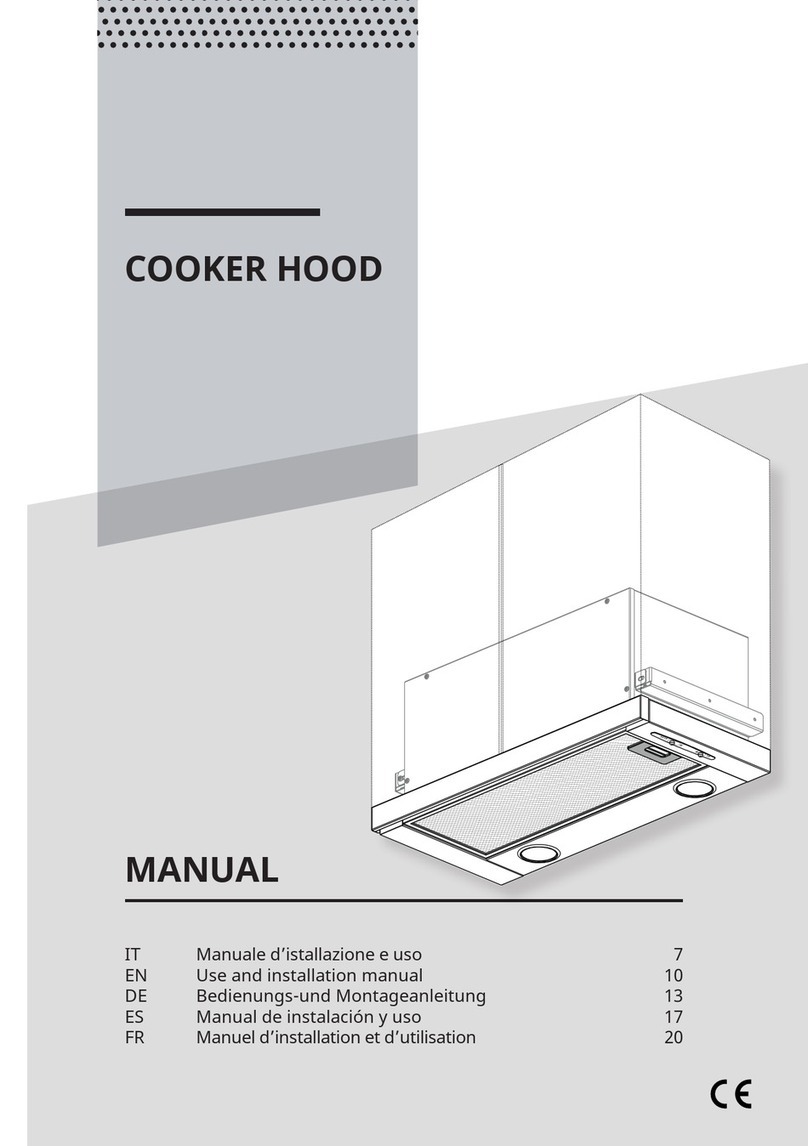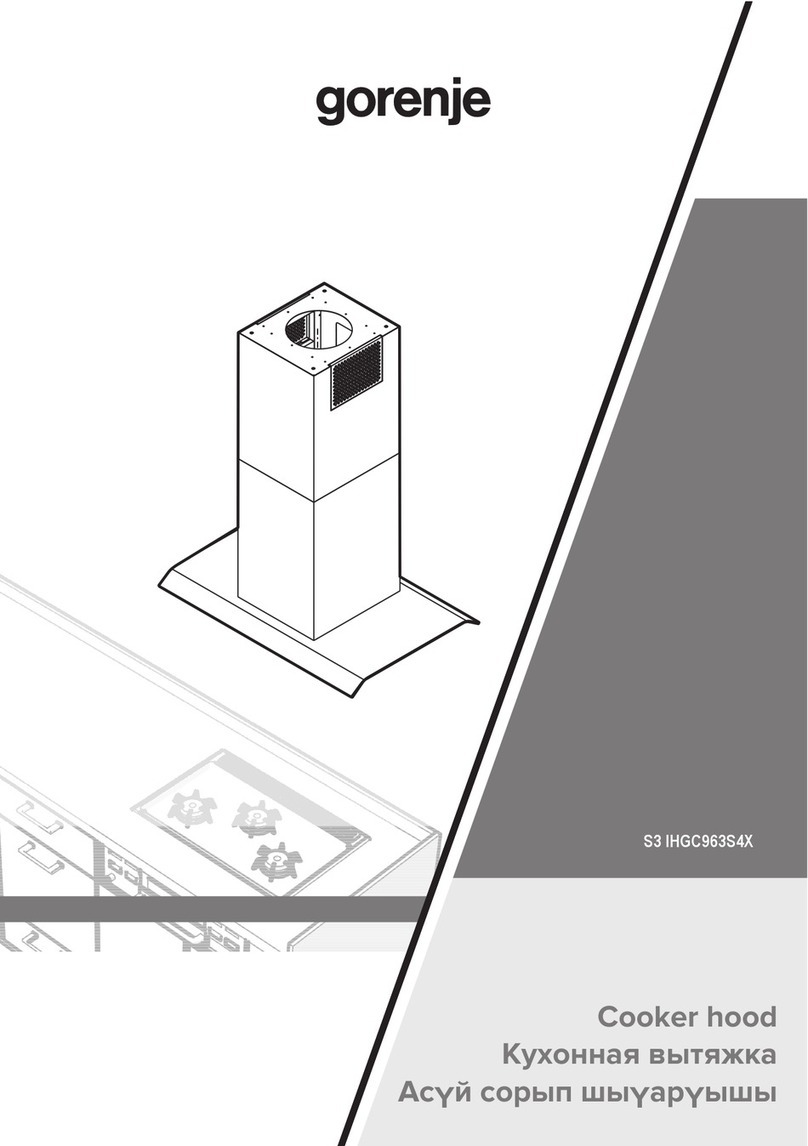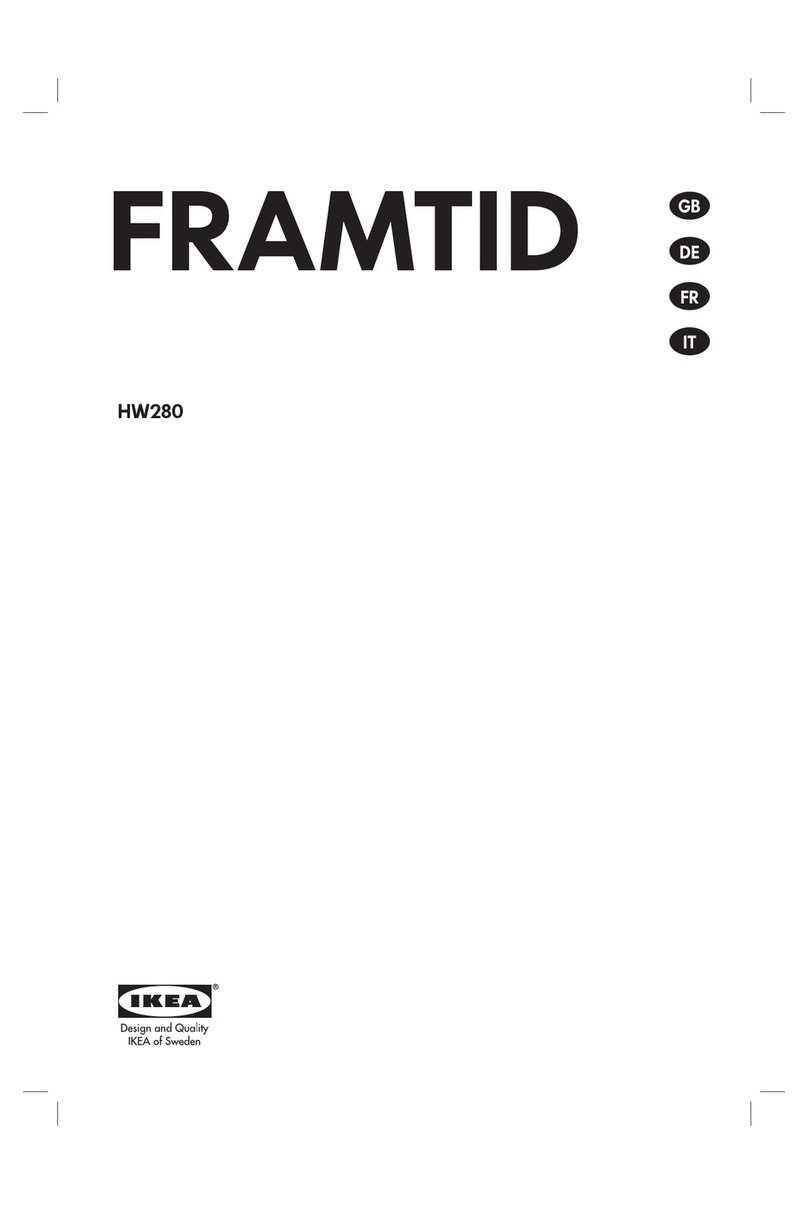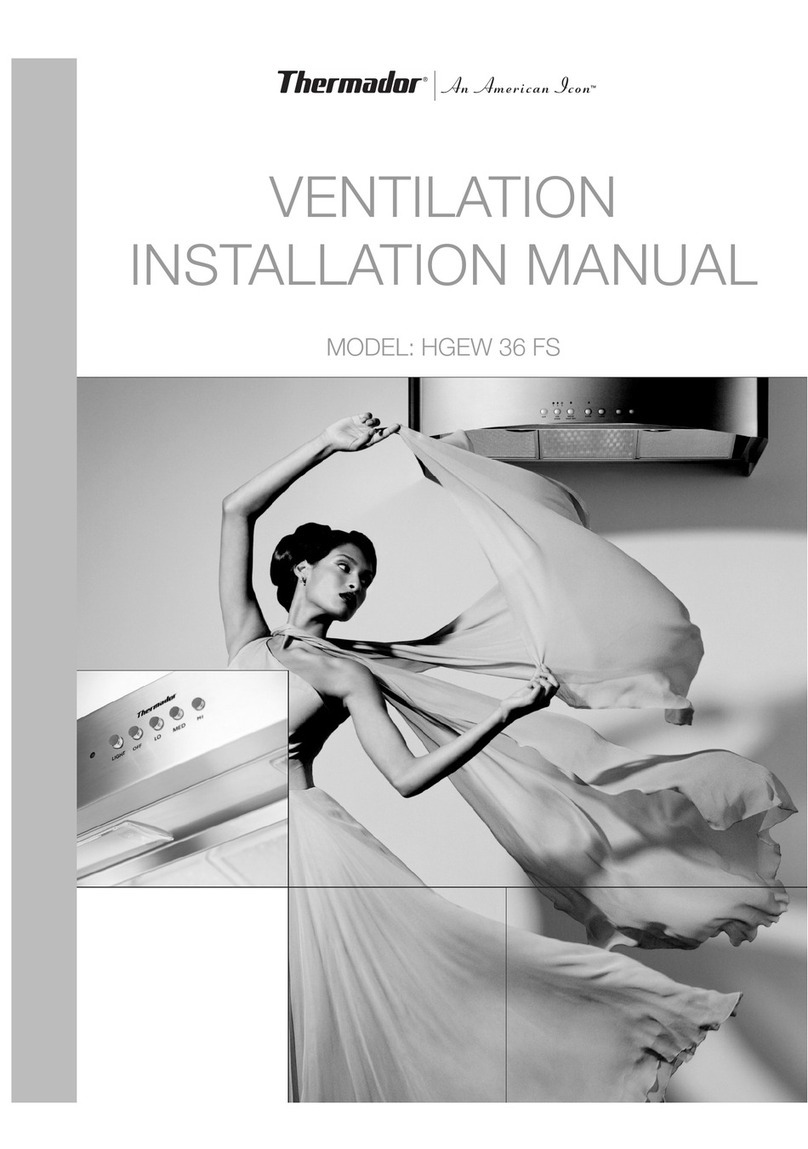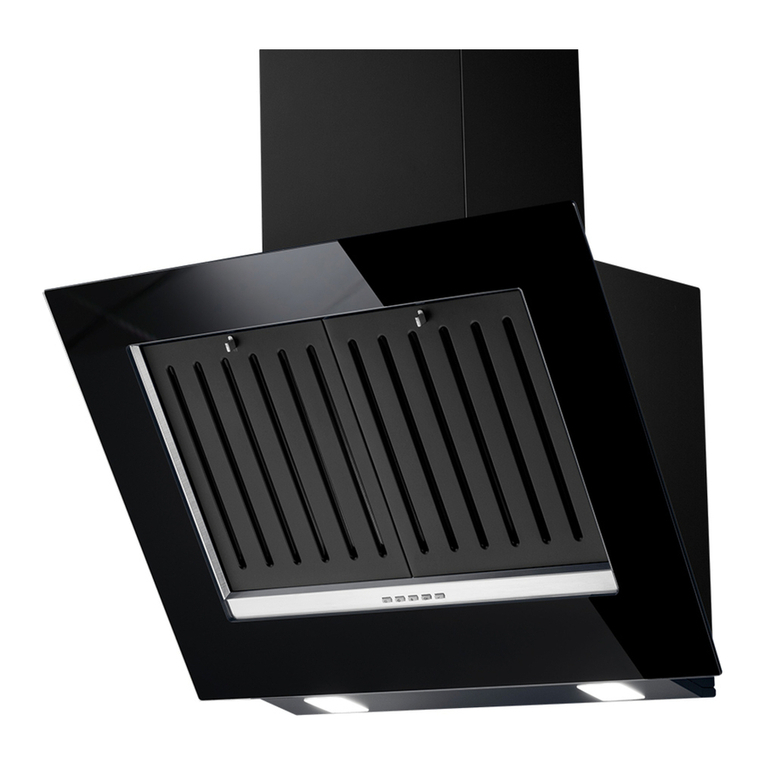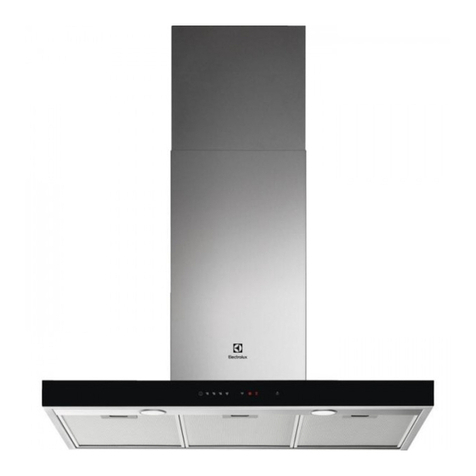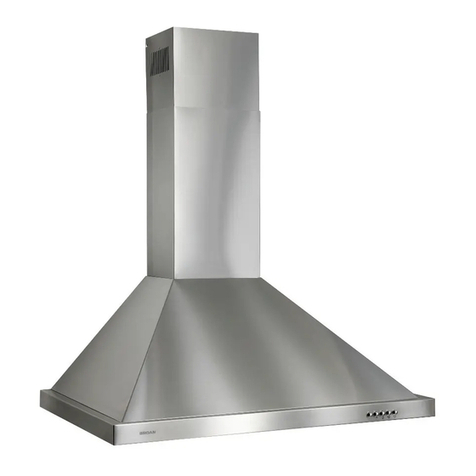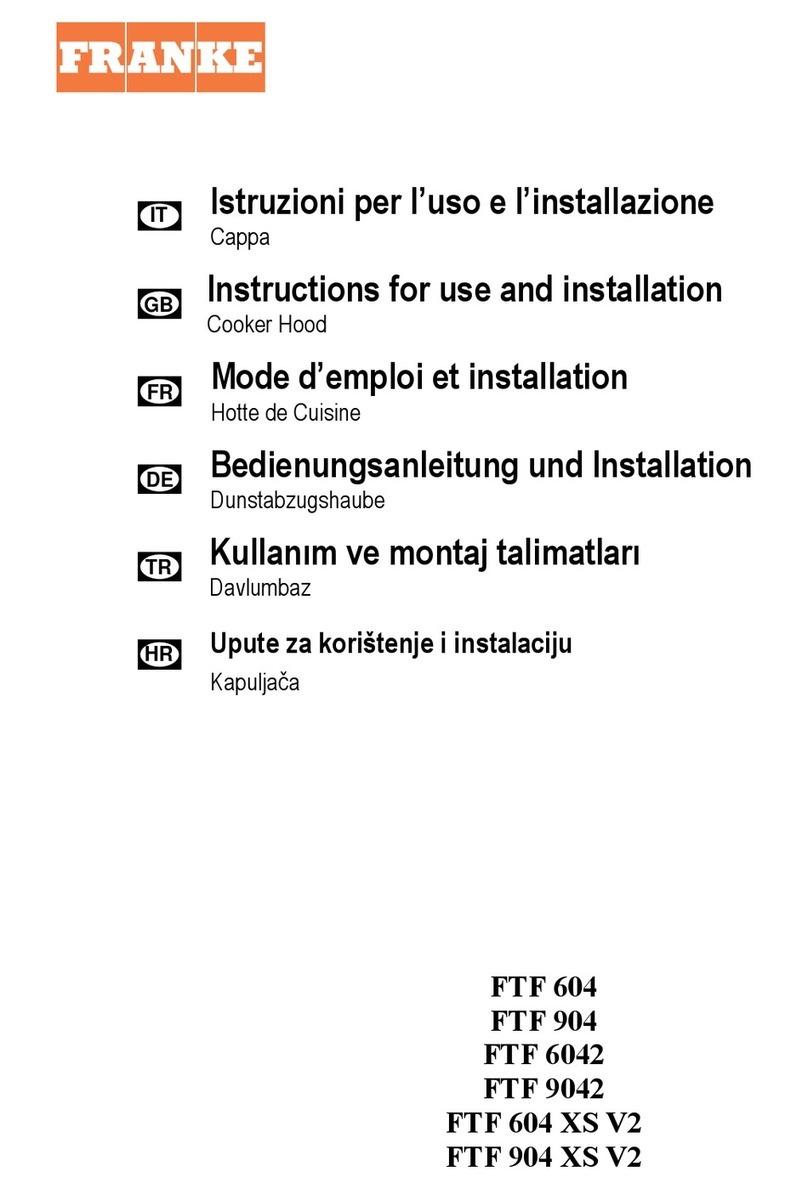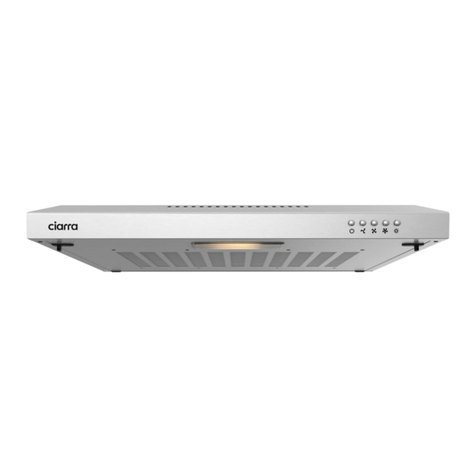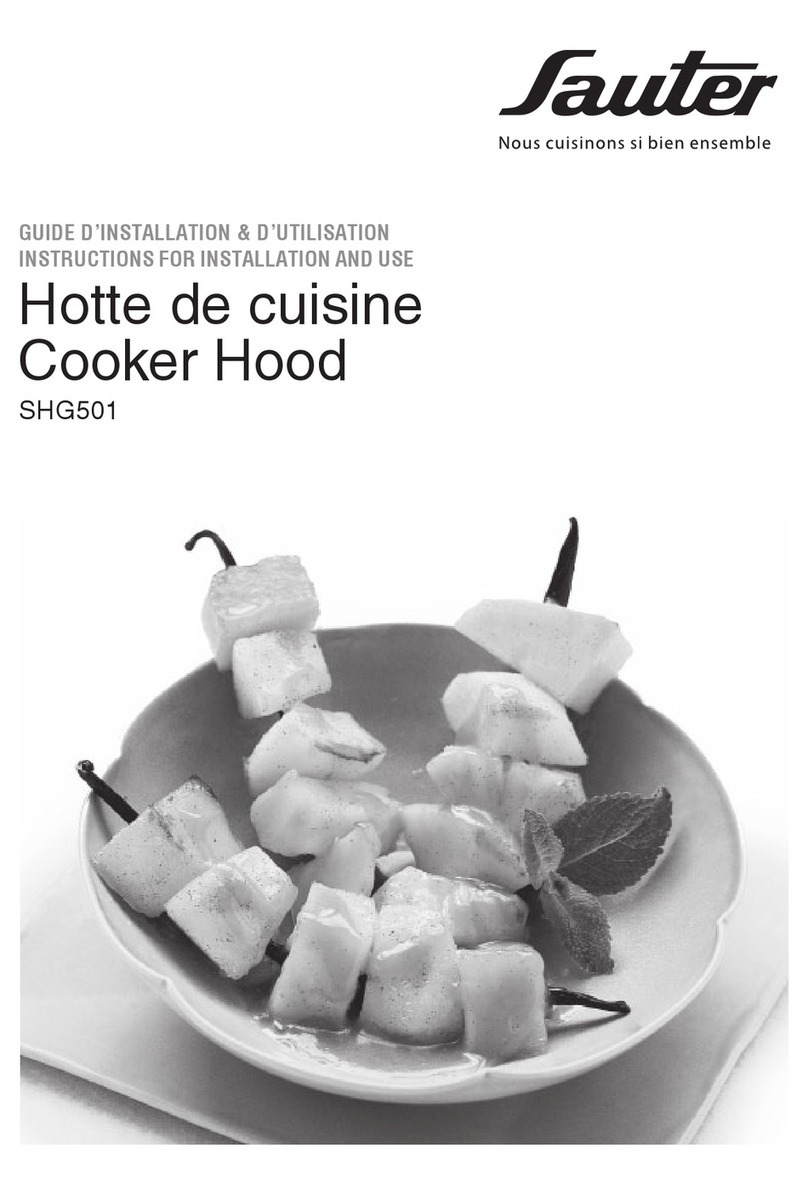
- 9 -
für Umwelt und Gesundheit vorzubeugen.
Das auf dem Produkt oder auf den Begleitpapieren
befindliche Symbol sagt aus, dass dieses Produkt nicht
wie normaler Hausmüll behandelt werden darf, sondern
dass es einer geeigneten Sammelstelle für das Recycling der
elektrischen und elektronischen Geräteteile zugeführt werden
muss. Entsorgen Sie bitte das Altgerät gemäß der lokalen
Richtlinien. Für weitere Informationen hinsichtlich der Behand-
lung, der Wiederverwertung und des Recycling des Produkts
wenden Sie sich bitte an die zuständige lokale Stelle, an die
Sammelstelle für Hausmüll, oder an den Händler, bei dem Sie
das Gerät erworben haben.
INSTALLATIONSANLEITUNG
•MontageundAnschlussmüssenvoneinemFachmann
durchgeführt werden.
•VorderAusführungderMontagearbeitenSchutzhand-
schuhe anlegen.
•Elektroanschluss:
Isolierklasse II
-Die Küchenhaube gehört zur Geräteklasse II, daher muss
keine der Leitungen geerdet werden. Der Stecker muss nach
der Montage des Geräts leicht zugänglich sein. Sollte das
Gerät mit einem Kabel ohne Stecker ausgestattet sein, ist für
den Anschluss an das Stromnetz ein allpoliger, der Last und
den einschlägigen Vorschriften entsprechender Schalter mit
einer Kontaktmindestöffnung von 3 mm zwischen Gerät und
Stromnetz vorzusehen.
-Der Anschluss an das Stromnetz ist folgendermassen durch-
zuführen:
BRAUN = LLeitung
BLAU = NNulleiter.
• Der Mindestabstand zwischen der Stellfläche für die Koch-
behälter auf der Kochvorrichtung und dem unteren Teil der
Abzugshaube muss mindestens 65 cm betragen. Falls ein
Verbindungsrohr verwendet wird, das aus zwei oder mehr
Teilen zusammengesetzt ist, muss der obere Teil über den
unteren gestülpt werden. Auf keinen Fall darf das Abluftrohr
der Küchenhaube an ein Rohr angeschlossen werden, in dem
Warmluft zirkuliert oder das zur Entlüftung von Geräten ver-
wendet wird, die an eine andere Energiequelle als an Strom
angeschlossen sind.
-Sollte das Gerät mit Abzugsvorrichtung montiert werden,
bereiten Sie eine Luftabzugsöffnung vor.
• Es empfiehlt sich der Einsatz eines Luftableitungsrohres,
das denselben Durchmesser aufweist, wie der der Luftab-
zugsöffnung. Die Verwendung eines Reduzierstücks könnte
die Leistungen des Erzeugnisses beeinträchtigen und das
Betriebsgeräusch erhöhen.
•Befestigunganderwand:
Vor der Installation der Dunstabzugshaube an der Wand
müssen die in Abb. 1 angeführten Maße kontrolliert werden,
dabei ist auch der Mindestabstand von der Kochfläche zu
berücksichtigen.
- Die 4 Bohrungen für die Befestigung anzeichnen und aus-
führen (Abb.1).
- Die 4 Spreizdübel Aund die 2 Schrauben B1 befestigen, ohne
sie vollkommen anzuschrauben Abb. 1.
- Die 4 Schrauben Edes Deckels Dentfernen, Abbildung
2 - Schritt 1-2.
- Die Abzugshaube ergreifen und an den 2 Schrauben B1
aufhängen, Abbildung 2 - Schritt 3.
- Die 2 Schrauben B1 festziehen, Abbildung 2 - Schritt 4,
und die Abzugshaube endgültig durch Anziehen der beiden
Sicherheitsschrauben B2 an der Wand befestigen, Abbildung
2 - Schritt 5.
- Den Deckel Dwieder anbringen und ihn mit den 4 zuvor
entfernten Schrauben Ebefestigen, Abbildung 2 - Schritt 6-7.
- Verwenden Sie zur Geräteinstallation Schrauben und Dübel,
die für die jeweilige Wandart geeignet sind (zum Beispiel:
Betonwände, Wände aus Gipspappe usw.).
Sollten die Schrauben und Dübel als Geräteausstattung mit-
geliefert werden, stellen Sie bitte sicher, dass diese für die Art
derWand, an die das Gerät montiert werden soll, geeignet sind.
•Umluft-version:
Vor Durchführung der Wartungstätigkeiten des regenerier-
baren Aktivkohlefilters (waschbar), den/die Antifett-Filter
deaktivieren.
- Zuerst den Bügel entfernen und dann das Paneel herauszie-
hen, wie in (Abb.4) dargestellt.
BENUTZUNG UND WARTUNG
• Es wird empfohlen, die Dunstabzugshaube schon vor Koch-
beginn der Speisen einzuschalten. Es wird weiterhin empfoh-
len, das Gerät nach Beendigung des Kochvorgangs noch 15
Minuten weiterlaufen zu lassen, um den vollständigen Abzug
der Kochdünste zu gewährleisten. Die Leistungsfähigkeit der
Dunstabzugshaube hängt entscheidend von der Sorgfalt
und Regelmäßigkeit der Wartung ab, insbesondere die des
Fettfilters und die des Aktivkohlefilters.
•Der Antifett-Filter hat die Aufgabe, die in der Luft schweben-
den Fettpartikel zu fangen, daher kann er in unterschiedlichen
Zeitspannen verstopfen, je nach Gebrauch des Geräts.
- Um der Brandgefahr vorzubeugen, müssen mindestens alle
2 Jahre die Antifett-Filter per Hand gereinigt werden; dazu
verwendet man neutrale, nicht scheuernde Reinigungsmittel
oder man gibt ihn in die Spülmaschine bei niedriger Tempe-
ratur und kurzem Zyklus.
- Nach der Reinigung kann die Farbe etwas verändert sein.
Diese Tatsache ist kein Grund für eine Beschwerde, damit er
ausgewechselt wird.
•DieAktivkohlefilterdienen dazu, die Luft, die in die Umge-
bung zurückgeleitet wird zu reinigen; sie haben die Aufgabe,
die unangenehmen Gerüche, die während des Garvorgangs
entstehen, zu beseitigen.
- Die nicht regenerierbaren Aktivkohlefilter müssen minde-
stens alle 4 Jahre ausgewechselt werden. Die Sättigung der
Aktivkohle hängt davon ab, wie oft das Gerät benutzt wird,
vom Gartyp und von der Häufigkeit, mit der die Reinigung
des Antifett-Filters durchgeführt wird.
- Die regenerierbaren Aktivkohlefilter müssen per Hand mit
neutralen, nicht scheuernden Reinigungsmitteln gewaschen
werden oder man gibt ihn in die Spülmaschine bei einerTem-
peratur, die 65°C nicht überschreiten darf (der Waschzyklus
muss ohne Geschirr vollendet werden). Das überschüssige
Wasser entfernen ohne den Filter dabei zu beschädigen, die
Bauteile aus Kunststoff entfernen und das Vlies im Ofen min-
destens 15 Minuten lang circa bei einer Temperatur von max.
100°C trockenen. Um den regenerierbaren Aktivkohlefilter
wirkungsvoll zu erhalten, muss diese Operation alle 2 Jahre
wiederholt werden. Max. alle drei Jahre muss ein Auswech-
seln vorgenommen werden bzw. jedes Mal, wenn das Vlies
beschädigt ist.
•VorderMontagedesAntifett-Filtersunddesregenerier-
baren Aktivkohlefilters ist es unbedingt nötig sicherzustel-
len, dass diese gut getrocknet sind.
•DieHaubemusshäufigsowohlInnenalsauchAußen
gereinigt werden; dazu verwendet man ein mit denatu-
